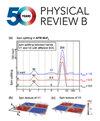Evidence for reduced periodic lattice distortion within the Sb-terminated surface layer of the kagome metal CsV3Sb5
IF 3.7
2区 物理与天体物理
Q1 Physics and Astronomy
引用次数: 0
Abstract
The discovery of the kagome metal CsV3Sb5 sparked broad interest, due to the coexistence of a charge density wave (CDW) phase and possible unconventional superconductivity in the material. In this Letter, we use low-energy electron diffraction (LEED) with a在kagome金属CsV3Sb5的sb端端表面层内降低周期性晶格畸变的证据
kagome金属CsV3Sb5的发现引起了广泛的兴趣,因为材料中存在电荷密度波(CDW)相和可能的非常规超导性。在这篇论文中,我们使用µm大小的电子束的低能电子衍射(LEED)来探索CDW相中锑端表面的周期性晶格畸变。我们在超高真空条件下记录了多个劈裂样品的高质量后向散射衍射图。出乎意料的是,我们没有发现上层结构反射的强度水平预测从动态LEED计算为报道的2×2×2体结构。我们的结果表明,在CsV3Sb5中,伴随着CDW的周期性晶格畸变在sb端表面比在本体中不那么明显。2025年由美国物理学会出版
本文章由计算机程序翻译,如有差异,请以英文原文为准。
求助全文
约1分钟内获得全文
求助全文
来源期刊

Physical Review B
物理-物理:凝聚态物理
CiteScore
6.70
自引率
32.40%
发文量
0
审稿时长
3.0 months
期刊介绍:
Physical Review B (PRB) is the world’s largest dedicated physics journal, publishing approximately 100 new, high-quality papers each week. The most highly cited journal in condensed matter physics, PRB provides outstanding depth and breadth of coverage, combined with unrivaled context and background for ongoing research by scientists worldwide.
PRB covers the full range of condensed matter, materials physics, and related subfields, including:
-Structure and phase transitions
-Ferroelectrics and multiferroics
-Disordered systems and alloys
-Magnetism
-Superconductivity
-Electronic structure, photonics, and metamaterials
-Semiconductors and mesoscopic systems
-Surfaces, nanoscience, and two-dimensional materials
-Topological states of matter
 求助内容:
求助内容: 应助结果提醒方式:
应助结果提醒方式:


